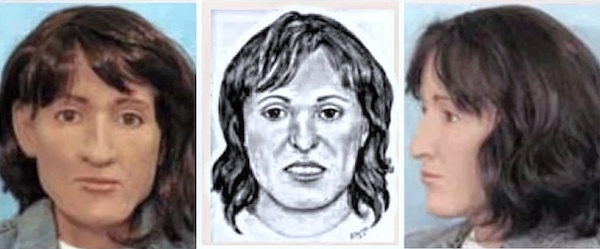Grace Doe
Investigators were told she would be identified only by the "Grace of God". Decades later, we helped identify Shawna, but questions remain.
In December 1990, a couple walking on a rural road in Southwest Missouri discovered the decomposed remains of a young woman. Her autopsy would later reveal that she had been sexually assaulted and murdered approximately two months prior to her discovery. She had been hog-tied and dumped next to an abandoned farmhouse and in spite of an extensive review of the crime scene, there were no clues to her identity. In fact, detectives were told that it would only be by the “Grace of God” that this she would ever be identified. This led to her unoffical name as Grace Doe.
Grace Doe was found restrained with six different types of bindings: nylon and lead ropes, coaxial and telephone cables, paracord, and clothesline. Investigators determined that the paracord was military grade MIL-C-5040H type II - a rope that was exclusively sold to the military in the 1990’s. This particular rope was not available to the public. In spite of this unique finding, investigators were unable to find who was responsible and she remained unidentified for three decades. In the three decades that passed, Grace Doe was McDonald County’s only unidentified persons case.

McDonald County Sheriff’s Office, Coroner’s Office, Missouri State Highway Patrol, Benton County Arkansas Sheriff’s Office, and the University of Arkansas were all involved in investigating the original crime scene. Through the years, Sheriff’s Schlessman, Evenson, and Hall worked the case and all available leads. In 2009, skeletal remains were sent to NamUs and a STR profile was produced, however it returned no matches in CODIS. A facial reconstruction was commissioned to help generate leads but no one recognized her. From 2009 to 2020, the Sheriff’s Office fielded calls from coast to coast, offering ideas on who “Grace” might be. The Sheriff’s Office followed up on all leads and used dental records and DNA testing to exclude possible matches from all over the country.
Last fall, the Othram team came across the case and we reached out to Sheriff Hall at McDonald County Sheriff’s Office and offered our assistance with the case. With all other leads exhausted, we wanted to apply Forensic-Grade Genome Sequencing® to help identify Grace Doe. Othram helps identify people from forensic evidence that has failed other methods. We operate the only laboratory in the United States that does this kind of work. There was immediate interest, but the only problem was that McDonald County is a small county with only one case of this kind and there was no budget for the work.
Encouraged by the recent success we had raising funds for the Mostly Harmless case, we decided upon a hybrid approach. First, we raised funds on the DNASolves® Crowdfunding platform. Second, thanks to generous gifts from donors who support experiential learning opportunities for Southeast Missouri State University students, the University Foundation contributed the rest of the funding. The Grace Doe case was our second collaboration with SEMO Anthropology — we previously worked together to identify a man found on a Missouri farm .
With the funds secured, we set out to use advanced DNA testing and forensic genealogy to establish an identification of, or to find the closest living relatives to Grace Doe. By January 2021, Othram’s researchers returned to the Sheriff’s Office candidate relatives. We asked the Sheriff’s Office to contact candidate relatives and investigators made contact with Danielle Pixler, a possible half-sibling. During the conversation, Ms. Pixler stated that she had a half-sister, Shawna Beth Garber, that had been in foster care and then went back into state care. Danielle did not know what happened with Shawna after she left foster care, but she has been searching for her for over 28 years.

Danielle agreed to contribute a DNA sample and it was sent to Othram for testing using a rapid familial test called KinSNP™ . I will explain KinSNP™ in a future post, but its a really cool test that combines the speed of traditional forensic STR testing, but with the ability to detect more distant relationships. Grace Doe is now identified as 22-year-old Shawna Beth Garber of Topeka, Kansas. The Sheriff’s Office says their next step is tracing the whereabouts of Shawna and determining what happened to her.
Shawna’s identity comes after decades of analyses and detective work from multiple local law enforcement agencies, anthropologists, university departments, and most recently, researchers at Othram. A vast majority of these cases can be solved by combining crowdfunding, volunteered data, DNA testing, and teamwork. Its a lot of work, but its always worth the effort. As I have mentioned before, even in the older cold cases, the families and friends of the victim wait years for answers. They need answers to find closure and to begin the healing process. We have the technology to provide those answers and therefore must act .

We must continue to advocate for applying technology and resources to the massive backlog of a few hundred thousand cold cases. Someone is always waiting for an answer, but folks can’t wait forever because none of us live forever. Any private citizen can make a difference. Learn more about how to get involved here .
If you want to learn more about the case of Shawna Beth Garber, here are some great links:
-
Some of the original press coverage when McDonald County Sheriff’s office first announced they were partnering with Othram to identify Grace Doe .
-
More information about the identification, including an interview with Danielle Pixler , Shawna’s half-sister.
-
Othram maintains a profile on this case at DNASolves.com .
« Back to the blog